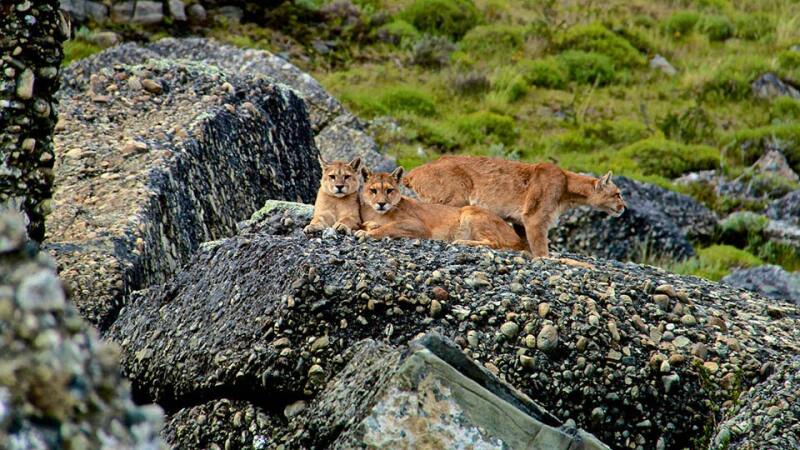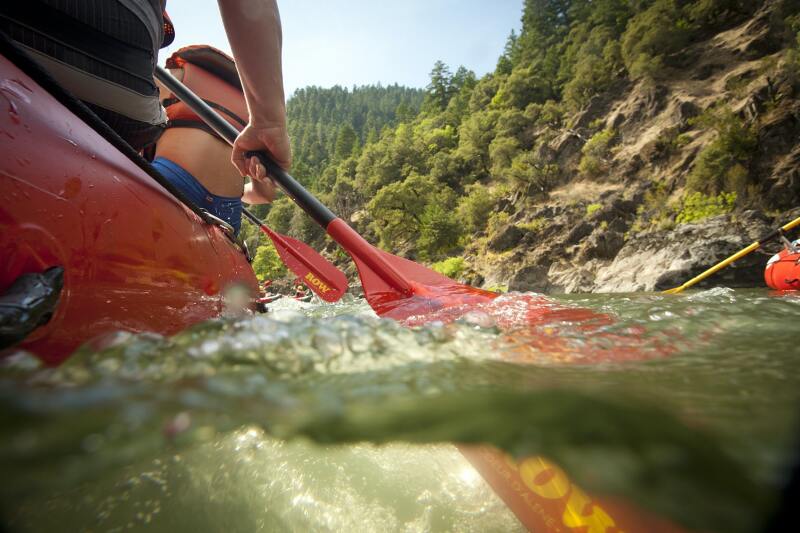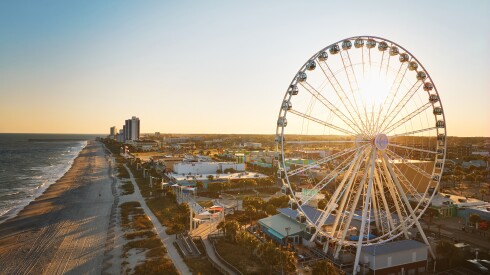Go on Safari in Chile
In the mountains and grasslands of Patagonia, track the largest puma in the world. For six days with Quasar Expeditions, wildlife and photography fans focus on the largest land carnivore in Chile: the Patagonian puma. In Torres del Paine National Park, these mountain lions stake out home ranges of 100 miles that stretch from deep within forests to mountain caves. A pair of experienced trackers helps guests observe these magnificent predators. You won’t waste any time waiting around, either—a dedicated tracker will radio in when a puma is spotted.
Daily game drives usually lead to many other animal sightings. You might see guanacos⎯mammals related to the Andean llama and the African camel that are among the puma’s food sources; other notable species include gray foxes, red foxes, hairy armadillos, hog-nosed skunks, and birds such as Andean condors, Chilean flamingos, Austral parakeets, and crested caracaras.

Pumas, also known as cougars or mountain lions, live as far north as the Canadian Yukon and as far south as the Andes.
Courtesy of Secret Compass
The best times to lay eyes on pumas—dawn and dusk—are also optimal times to admire some of the park’s best features. Watch the sun hit the granite towers of the Torres del Paine, make a halo of a guanaco’s furry coat, or illuminate Sarmiento Lake’s otherworldly blue.
Tracking the World’s Largest Mountain Lion: The Patagonian Puma
From $6,250. Departures year-round.
Pick Up a Paddle in Oregon

River rapids classes are ranked from I (easy) to VI (extremely difficult).
Courtesy of ROW Adventures/Jared Cruce
Go with the flow through river rapids in the Pacific Northwest.
Fifty years ago, when the Rogue River became one of eight rivers in the United States protected by the Wild and Scenic Rivers Act, the surrounding rugged, complex canyon landscape in southwestern Oregon was protected, too. ROW Adventures makes the region accessible to voyagers of all levels with three- or four-day rafting excursions that don’t even require you to sleep in a tent. Splash through white water during the day and unwind at riverside inns every night.
The adrenaline flows as you pass through no fewer than 80 rapids over the course of more than 40 miles, looking out for wildlife such as black bears and river otters along the way. Rare plants, including the endemic Rogue River stonecrop, a flowering succulent, bloom on the slopes of the surrounding Siskiyou and Klamath mountains, and trail hikes and walks to historic homesteads break up your time on the water.
Rogue River Rafting
From $895. Regular departures begin for the season in May 2019.
Venture to Eastern Greenland

The town of Tasiilaq is the largest on Greenland’s eastern coast.
Courtesy of Natural Habitat Adventures/Ralph Lee Hopkins,
Discover the glacial beauty and customs of the world’s largest island.
Natural Habitat Adventures leans on more than thirty years of Greenland expertise, and it shows: It runs the only luxury base camp (outfitted with safari-style tent cabins that have private verandas) in East Greenland, and its expedition leaders are among the most experienced in the business.
During the nine-day summer excursion, a helicopter or boat delivers travelers to the camp on the shores of East Greenland’s Sermilik Fjord. By then, the snow has melted, giving way to plentiful berries and Arctic wildflowers. The views—of icebergs as large as buildings, of the Greenland ice sheet (which stretches over 1,500 miles from north to south), and of seals at play in the frigid waters—are unparalleled. Guided kayak excursions allow visitors to take an even closer look.
Despite harsh conditions most of the year, traditional living still thrives. Meet artisans who make handicrafts of stone and bone in Tasiilaq, drink tea with a local and learn about traditional beadwork in the village of Tinit, and watch a traditional drum dance in Kulusuk. A final perk: Natural Habitat Adventures offsets 100 percent of the carbon emissions from its trips.
Discover Greenland: The Natural Habitat Experience
From $10,995. Seasonal departures begin in July 2018 and July 2019.
Walk the Deserts of Oman

Visitors to Nizwa might catch a goat auction at the souk.
Ian Berry/Magnum Photos
Take a hike through the ancient soul of Arabia.
The inland beauty of Oman—jagged mountains, vast sand dunes, rocky wadis (seasonally dry gorges), and preserved fortresses—is the star of a seven-day Butterfield & Robinson tour. The journey starts with a visit to Wadi Nakhar (also known as Oman’s Grand Canyon): Take the three-hour “balcony walk” along its red rim or hike through the gorge itself, where the changing light and shadow on canyon walls and acacia trees mark the passage of time. If you choose the latter, you might also catch craftsmen making rugs of goat hair once you arrive in the valley village of Al Nakhar. Day three marks the trip’s midway point in Nizwa, the site of one of the oldest souks in the country. There, bargain for a silver khanjar, a curved ceremonial dagger so important that it appears on the national flag. Its scabbard forms a 45-degree angle, unique among other Middle Eastern specimens. You’ll spend time with Bedouins while camping in the Wahiba Sands and take a day to explore the waterfalls, turquoise pools, and pockets of palm trees among the cliffs of Wadi Shab.
Oman Walking: Mysticism Among the Mountains
From $6,995. November 10–16, 2018; 2019 departures also available.
Cruise the Kimberley Coast of Australia

The only way to arrive at the Horizontal Falls is by boat or aircraft.
Photo by David Bettini
Set sail on the northwestern waters of the land down under.
Australia’s Kimberley region—an immense and diverse landscape in the northern part of the country that encompasses gorges, waterfalls, rain forests, cave systems, and a variety of wildlife—is one of the world’s last great wilderness areas. The luxury adventure ship Le Laperouse carries 150 cruisers through archipelagoes and along the wild Kimberley coast on this 13-day Abercrombie & Kent tour, which blends nature and culture.
Take a jet-boat tour through the Horizontal Falls of Talbot Bay, waterfalls created by massive tidal currents squeezing through two narrow gorges. Helicopter to sandstone-carved Mitchell Falls, where passengers may soak or swim in the emerald pools at the bottom and take a nature tour on foot. Or get a glimpse of the striking, beehive-striped Bungle Bungle mountain range on a scenic flight over the northernmost reaches of the Kimberley.
An onboard specialist lends insight into the region’s history of Aboriginal peoples, and the cruise itinerary includes outings to see ancient paintings and rock art sacred to the indigenous Wunambal and Worrorra populations. Visits with local residents help illuminate modern-day life in these cultures, and their connection to ancient ways.
Kimberley Cruise: Australia’s Last Frontier
From $12,495. June 20–July 2, 2019.
Herd Reindeer to Pasture in Russia

Your lodging for the night in Siberia? A reindeer-hide tent called a “chum.”
Photo by Jen Judge
In the outer reaches of Siberia, assist with an age-old tradition of reindeer migration.
For more than 1,000 years, the Nenets people have lived on what is called “the end of the world” in the local language: the Yamal Peninsula, a swath of peatland extending from northern Siberia to the Arctic Ocean. Join them there on a 17-day journey with Secret Compass, and you’ll help herd their reindeer during the annual migration to pasturelands near the Arctic Circle.
Intensive cultural immersion with the Nenets is a key part of the experience. Guests live with some of the families, wear traditional fur and hand-sewn herders’ clothing, sleep in reindeer-hide tents known as chums, and brave the Arctic weather conditions. (Temperatures can drop to −40 degrees.) Daily life involves dismantling the tent, packing the wooden box sledges pulled by snowmobiles, and rounding up the reindeer every few days to move to fresh pastures. A highlight is crossing the frozen Gulf of Ob: Because there is no food for the animals on the frigid surface, herders and travelers must urge the reindeer on until they reach the far shore, a distance of some 37 miles. That leg of the journey can take up to 24 sleepless hours.
The migration culminates in the annual Reindeer Herding Festival in Yar Sale village. Hundreds of Nenets arrive from the surrounding taiga forest and tundra to compete in such traditional contests as reindeer lassoing, sledge racing, sledge jumping, and wrestling.
Nenets Reindeer Migration
From $2,326. March 24–April 9, 2019.
Tour the Border of Pakistan and China

Courtesy of Nature Expedition
Drive the historic Silk Road and see little-known terrain in the Hunza Valley.
When was the last time you met someone who just got back from a vacation in Pakistan? Claim bragging rights by taking a 20-day Geographic Expeditions adventure that opens the door to corners of Pakistan and China that are difficult for most travelers to reach.
Begin on the Silk Road in Kashgar, China, the center of regional trade, where artisans still craft wooden musical instruments and copper tea urns as they’ve done for hundreds of years. From there, guests travel along the Karakoram Highway over the 15,397-foot high Khunjerab Pass and into northeastern Pakistan. In the Hunza Valley, glacier-fed rivers run at the foot of jagged peaks, and the area’s ancient capital, Karimabad, sits atop a green hill overlooking the expanse below.
Kick into four-wheel drive for an amateur archaeologist’s dream ride through the valley. A 7th-century Kargah Buddha carved into a nearby mountain, and 13th- and 14th-century mosques testify to the region’s layered religious history. And for nature enthusiasts, crossing the Deosai Plateau offers the rare opportunity to traverse regional habitats of endangered Himalayan brown bears and threatened snow leopards before spending a final night in a peaceful evergreen forest.
Hunza Valley of Pakistan
From $9,625. June 15–July 4, 2019 and August 31–September 19, 2019.











